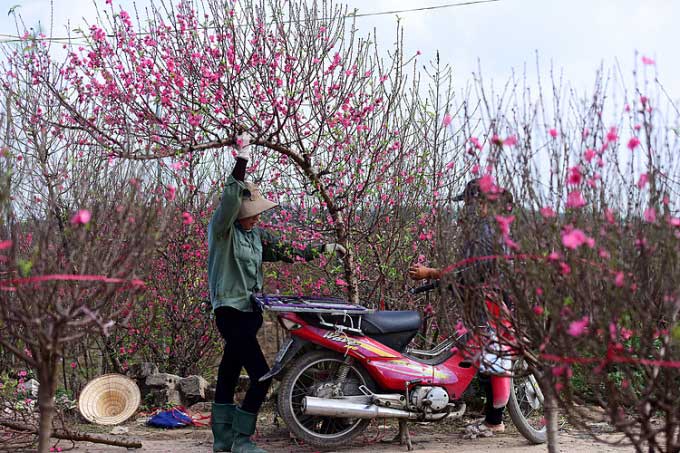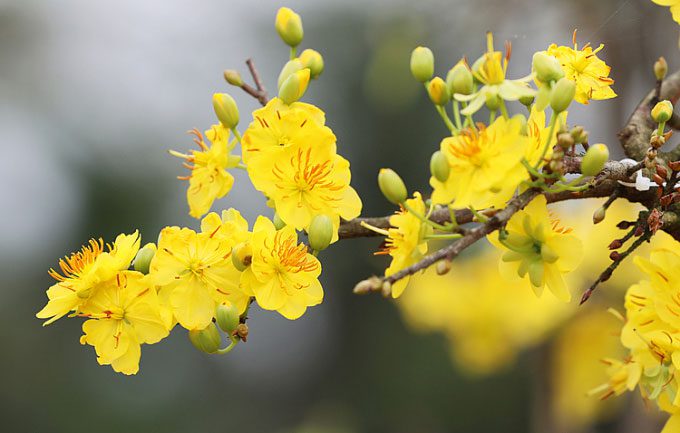Peach blossoms can help whiten skin, treat hair loss, and baldness; while apricot blossoms are used as a tonic, treating cough, headaches, dizziness, high blood pressure, and skin dermatitis.
Peach Blossoms
According to Traditional Chinese Medicine, the peach tree has the ability to eliminate negative energy, promote positive energy, and bring good luck. Various parts of the peach tree can also be used as medicine to treat illnesses.
General Practitioner Bui Dac Sang from the Institute of Science and Technology states that peach blossoms are a unique medicinal herb, with a neutral nature and a bitter taste. This type of flower can treat ailments related to the urinary system, prolonged dysentery, symptoms of cold-induced skin irritations, heart pain, baldness, hair loss, help with weight loss, and give women a fair, rosy, and smooth complexion while treating dark spots on the face.
Since ancient times, after the Lunar New Year, people often harvested peach blossoms, dried them in the shade, and stored them in a cool, dry place for medicinal use.

Japanese peach blossoms bloom during Tet. (Photo: Giang Huy).
Some beauty recipes using peach blossoms include:
Mix equal amounts of dried peach blossoms and apricot blossoms with boiling water to wash your face.
For those with sensitive skin or chronic boils, you can use equal amounts of peach blossoms and salt, crush them together, mix with vinegar, and apply to the face. If there are yellow or pus-filled pimples on the face, you can use peach blossom powder or peach blossom tea to drink. This method helps gradually remove dark spots and blemishes.
People can use the peach blossom infusion to wash their faces, or grind peach blossoms and the seeds of winter melon (Dong Qua) finely, mix with honey, and apply to the face at night, rinsing off with warm water in the morning to reduce wrinkles.
Take 10 g of peach blossoms and 15 g of lotus flowers, dry them, grind finely, and divide into three portions to brew in a glass, adding boiling water like tea, and drink to treat unsightly pigmentation on the face.
100 g of peach blossoms, washed and soaked in one liter of white wine, sealed tightly, can be consumed after a week, drinking 10 ml three times a day, which helps activate blood circulation and relieve pain.
Apricot Blossoms
The apricot tree is not only used for ornamental purposes during Tet but also has many applications in culinary and health care.
In the southern regions, people dry or roast the bark of the yellow apricot tree, then soak it in alcohol to extract the bitter compounds, which serve as tonics and aid digestion.
During Tet, with the consumption of fatty meats, pickled onions, and green sticky rice cakes, drinking a glass of bitter yellow apricot wine as an appetizer enhances the meal’s enjoyment. In Traditional Chinese Medicine, the roots of the yellow apricot can be used as a laxative for tapeworms and to treat headaches and dizziness.

Apricot blossoms bloom during Tet. (Photo: Ngoc Thanh).
Some medicinal recipes using apricot blossoms include:
Recipe for headaches and dizziness: Boil 9 g of apricot blossoms to drink or combine apricot blossoms with sea beans and fresh lotus leaves in appropriate amounts, boil, and drink. Use 15 g of apricot blossoms, 15 g of white chrysanthemum, and 15 g of rose, steeped and consumed as tea.
To treat high blood pressure and angina: Use 3 g of apricot blossoms and 10 g of cassia seeds steeped in hot water in a sealed container, ready to drink in 15 minutes, consumed throughout the day as tea.
To treat stomach pain, mild hepatitis, and cirrhosis: Boil 5 g of apricot blossoms with 100 g of white rice to make porridge, adding white sugar, divided into several meals throughout the day.
To treat persistent cough: Brew 9 g of apricot blossoms as tea throughout the day. Prepare 10 g of apricot blossoms, 10 g of licorice, and 60 g of white rice, boil together into porridge, adding a little honey, divided into several meals throughout the day.
To treat joint pain due to rheumatism: Use 9 g of apricot blossoms, 9 g of shepherd’s purse, and 9 g of windblown thistle, soaked in 200 ml of alcohol, drinking 30-50 ml each time.
To treat skin dermatitis: Soak 6 g of apricot blossoms in peanut or sesame oil, and after two weeks, apply twice daily to affected areas.
Practitioner Sang recommends that the above remedies are for reference only, and individuals should consult and follow the treatment plans prescribed by their doctors when ill.


















































